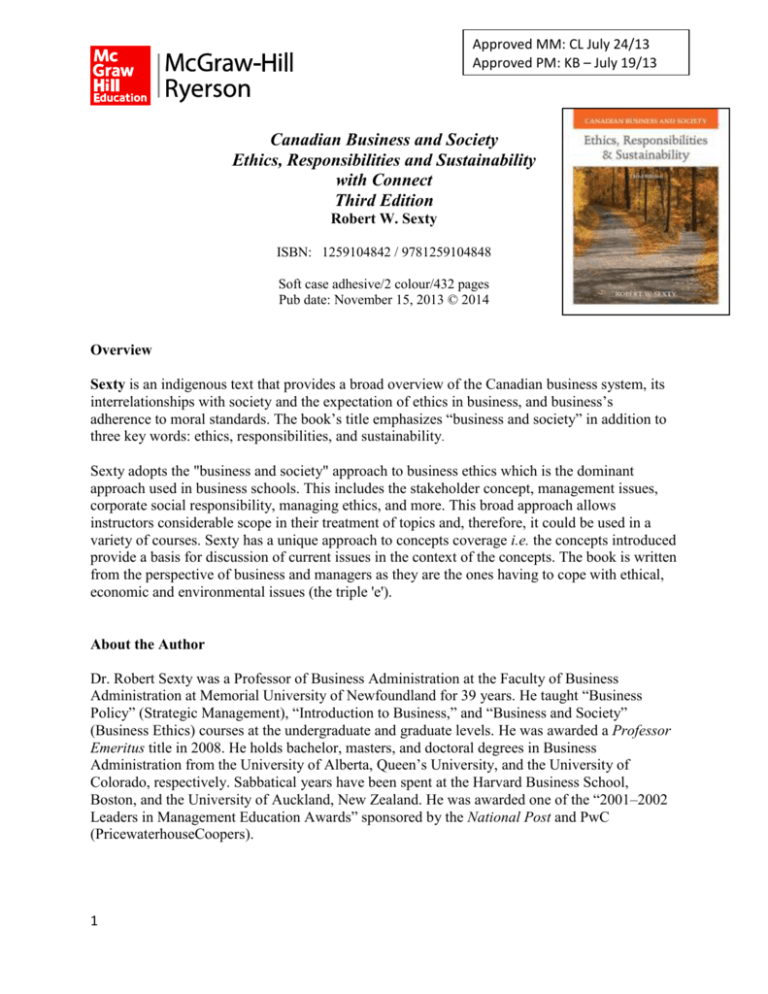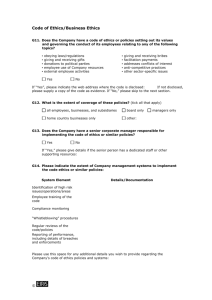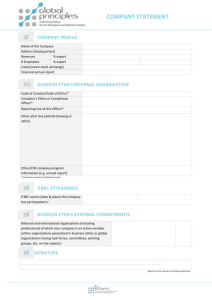Principles of Microeconomics
advertisement

Approved MM: CL July 24/13 Approved PM: KB – July 19/13 Canadian Business and Society Ethics, Responsibilities and Sustainability with Connect Third Edition Robert W. Sexty ISBN: 1259104842 / 9781259104848 Soft case adhesive/2 colour/432 pages Pub date: November 15, 2013 © 2014 Overview Sexty is an indigenous text that provides a broad overview of the Canadian business system, its interrelationships with society and the expectation of ethics in business, and business’s adherence to moral standards. The book’s title emphasizes “business and society” in addition to three key words: ethics, responsibilities, and sustainability. Sexty adopts the "business and society" approach to business ethics which is the dominant approach used in business schools. This includes the stakeholder concept, management issues, corporate social responsibility, managing ethics, and more. This broad approach allows instructors considerable scope in their treatment of topics and, therefore, it could be used in a variety of courses. Sexty has a unique approach to concepts coverage i.e. the concepts introduced provide a basis for discussion of current issues in the context of the concepts. The book is written from the perspective of business and managers as they are the ones having to cope with ethical, economic and environmental issues (the triple 'e'). About the Author Dr. Robert Sexty was a Professor of Business Administration at the Faculty of Business Administration at Memorial University of Newfoundland for 39 years. He taught “Business Policy” (Strategic Management), “Introduction to Business,” and “Business and Society” (Business Ethics) courses at the undergraduate and graduate levels. He was awarded a Professor Emeritus title in 2008. He holds bachelor, masters, and doctoral degrees in Business Administration from the University of Alberta, Queen’s University, and the University of Colorado, respectively. Sabbatical years have been spent at the Harvard Business School, Boston, and the University of Auckland, New Zealand. He was awarded one of the “2001–2002 Leaders in Management Education Awards” sponsored by the National Post and PwC (PricewaterhouseCoopers). 1 Third Edition Changes Connect™ - NEW to the Third Edition containing instructor and student resource material, web links, exercises, videos, Management Asset Gallery, cases, full eBook, assessment bank and SQS for students. The most substantive content change is a focus on corporate sustainability. Little agreement exists in the academic and practitioner literature on a definition of the concept. In this book, corporate sustainability (CS) refers to activities demonstrating the inclusion of social and environmental as well as economic responsibilities in business operations as they impact all stakeholders to ensure the long-term survival of the corporation. The term sustainability was first used in the context of environmental sustainability, but corporate sustainability has a wider meaning and includes economic, ethical, and social responsibilities as well. The difference from corporate social responsibility (CSR) is that the responsibilities are completely integrated into the structure, policies, and operations of the corporation. Corporate sustainability is referenced throughout the book, and Chapter 16 outlines sustainability strategy. Other new topics introduced include: social license (Chapter 1); conscious capitalism and shared value (Chapter 2); crisis management (Chapter 3); unethical leadership (Chapter 6); the Value/Balance/Accountability (VBA) model (Chapter 7); the for-benefit or B Corporation and community bonds (Chapter 8); deregulation and the role of government in CSR (Chapter 10); workplace privacy (Chapter 12); service learning (Chapter 16); More coverage is given to: research findings about CSR and employees and consumers (Chapter 12); additional materials are provided on supply chains (Chapter 12); non- governmental organizations (NGOs) and business partnerships (Chapter 13); bribery and microfinance (Chapter 15). 2 Features and Benefits of the Book Book’s Organization. Business and the corporation operate within various societal environments which are the basis for the book’s organization and are further discussed in various chapters – refer to the Preface for complete detail. o Business Environment o Stakeholder Environment o Ethical Environment o Social Environment o Regulatory Environment o Ecological Environment o International Environment A unique approach. Each chapter offers unique materials or extensive descriptions of various topics as they relate to the ethics, responsibilities, and sustainability of business. Topics include academic integrity in business schools, the stakeholder concept and approaches to understanding the stakeholders, discussion of corporate sustainability, measuring, reporting, and communicating CSR, and more. A building approach. The sequence of the chapters and the concepts covered enable students to learn about business and society incrementally. For example, concepts relating to capitalism and the economic responsibilities of the corporation are introduced early, followed by the stakeholder concept. This information is essential to understanding the subsequent chapters. A focus on Canadian content. The material in the book emphasizes Canadian content; it is an indigenous text rather than a conversion of an American or European text. Business and managerial perspectives. The book is written from the perspective of business and managers, as they have to cope with social, ethical, and environmental responsibilities while also having to meet economic responsibilities. The materials increase the understanding of businesspersons and their influence on society and of society’s influence on business. Both good and undesirable examples of business behaviour are presented. Non-profit sector included. Non-profit organizations also play a role in business and society. This sector is represented by stakeholders such as non-governmental organizations, educational institutions, religious groups, and charities. A student perspective. Efforts have been made to present materials, vignettes, example inserts, and cases to which students can relate. Students are the future business leaders and managers and must understand the dynamic relationship between business and society and the ethics and responsibilities involved. 3 Chapter Pedagogy NEW Boxed Features: o “Learn more” boxes. Readers who want to know more about certain topics are directed to “Go to Connect” where applicable. A list of ‘Learn more’ Chapter topics is in the Preface. o “Your Advice to…” boxes. These boxes have been placed before each chapter summary and relate back to the chapter’s opening vignette. Learning Outcomes. At the beginning of each chapter, numbered Learning Outcomes are listed. These tie in with the numbered section headings in each chapter. In-depth examples. Lengthier boxed inserts allow for more discussion of the examples. The two types of boxes are: Everyday Ethics: Examples of best practices—or inappropriate or questionable practices. Over 23 new Everyday Ethics have been included and all the remaining ones updated. Instructors are provided with additional information to facilitate classroom discussion in the Instructor’s Manual and Online Responsibility for Ethics: Refer to or describe individuals, organizations, practices, or concepts that affect or influence the behaviour of business leaders, managers, or corporations. Most describe the roles or influence of stakeholders. Ten new Responsibility for Ethics boxes have been included and the remaining ones updated. End-of-Chapter Cases. Cases relevant to the chapter material can be found in the end-ofchapter material. There are two types: descriptive of an issue in business and society to which management must respond and are a basis for discussion, and decision-making in that the student faces a dilemma which must be addressed. Ten new cases and many others have been altered and updated. Opening vignettes. All vignettes are original and based on Canadian materials and examples. Each chapter begins with a real-world situation which introduces the chapter content. Six new vignettes are included in this edition and several others have been revised. Critical Thinking and Discussion questions. Every chapter ends with a set of questions that challenge the students to apply the concepts they have learned in each chapter. Ethics and Responsibilities Cases. Longer cases are included at the end of the text that allow for more in-depth discussion of issues and dilemmas relating to the ethics and responsibilities of business. There are two types: descriptive of an issue in business and society and decisionmaking where a dilemma is faced and must be addressed. Three new cases have been added for a total of 10 cases. 4 Table of Contents PART I: INTRODUCTION TO BUSINESS AND SOCIETY CHAPTER 1: The Relationship between Business and Society CHAPTER 2: Ethics and Capitalism PART II: BUSINESS, STAKEHOLDERS, AND ISSUES CHAPTER 3: Identifying Stakeholders and Issues CHAPTER 4: Stakeholder Relations and Analysis PART III: ETHICAL AND SOCIAL RESPONSIBILITIES CHAPTER 5: Ethics of Business: The Theoretical Basis CHAPTER 6: Ethics of Business: Management and Leadership CHAPTER 7: Corporate Social Responsibility: The Concept CHAPTER 8: Corporate Social Responsibility: In Practice CHAPTER 9: Measuring, Reporting, and Communicating CSR PART IV: INFLUENCING CANADIAN BUSINESS CHAPTER 10: Regulating Business CHAPTER 11: Ownership and Governance of the Corporation CHAPTER 12: Ethics and Responsibilities in the Workplace and Marketplace CHAPTER 13: Civil Society Stakeholders PART V: THE ENVIRONMENT, GLOBALIZATION, AND STRATEGY CHAPTER 14: The Environment and Business Responsibilities CHAPTER 15: Globalization and Business Responsibilities CHAPTER 16: Sustainability Strategy Ethics, Responsibilities and Sustainability Cases Glossary Endnotes Index Supplements CONNECT McGraw-Hill Connect™ is a Web-based assignment and assessment platform that gives students the means to better connect with their coursework, with their instructors, and with the important concepts that they will need to know for success now and in the future. With Connect, instructors can deliver assignments, quizzes, and tests online. Nearly all the questions from the text are presented in an auto-gradeable format and tied to the text’s learning objectives. Instructors can edit existing questions and author entirely new problems. Track individual student performance—by question, assignment, or in relation to the class overall— 5 with detailed grade reports. Integrate grade reports easily with Learning Management Systems (LMS) such as WebCT and Blackboard. And much more. By choosing Connect, instructors are providing their students with a powerful tool for improving academic performance and truly mastering course material. Connect allows students to practise important skills at their own pace and on their own schedule. Importantly, students’ assessment results and instructors’ feedback are all saved online— so students can continually review their progress and plot their course to success. Connect also provides 24/7 online access to an eBook—an online edition of the text— to aid them in successfully completing their work, wherever and whenever they choose. Instructor Resources: Instructor’s Manual: Written by the text author, the IM includes for each chapter the "solution" to the opening vignette, material by section with the objective for each section, additional information on the boxes, additional notes/materials/suggestions for instructors, responses to discussion questions, analysis of cases, additional resources, video resources and assignments/questions. EZ Test - Computerized Test Bank: A ground-up comprehensive Test Bank that consists of true/false, multiple choice and essay-type questions, and enables instructors to add their own questions. PowerPoint Presentation Slides: A set of PowerPoint slides, per chapter, provide an overview using illustrations, definitions, and examples, focusing on the primary concepts in each chapter. Management Asset Gallery – for Instructors and Students Management Asset Gallery: a one-stop-shop for a wealth of assets making it easy for instructors to locate specific materials to enhance their course. The Asset Gallery includes non text-specific management resources (Self-Assessments, Test Your Knowledge exercises, Video's* and information, additional group & individual exercises) along with supporting PowerPoint® and Instructor Manual materials. *The ‘Management in the Movies’ videos are not licensed for distribution outside of the USA, however adopting instructors are able to access the Instructor Notes. Manager’s Hot Seat Online (within the Management Asset Gallery) In today’s workplace, managers are confronted daily with issues such as ethics, diversity, working in teams, and the virtual workplace. The Manager’s Hot Seat is an online resource that allows students to watch as 15 real managers apply their years of experience to confront these issues. Students assume the role of the manager as they watch the video and answer multiple choice questions that pop up, forcing them to make decisions on the spot. They learn from the manager’s mistakes and successes, and then write a report critiquing the manager’s approach by defending their reasoning. Reports can be e-mailed or printed out for credit. These video segments are a powerful tool for your course that truly immerses students in the learning experience. 6 Connect Student Resources: o eBook o Self-Quiz and Study o Student Asset Gallery o Quiz questions o Web Links and Internet Questions o Key Terms, Searchable and Audio Glossary 7





